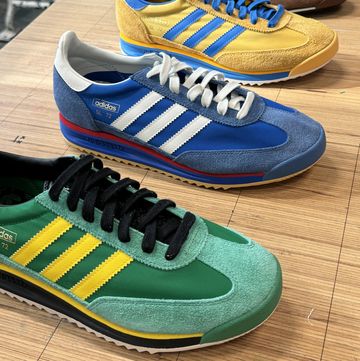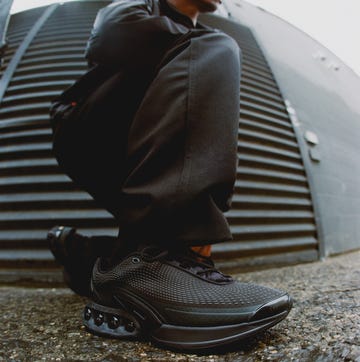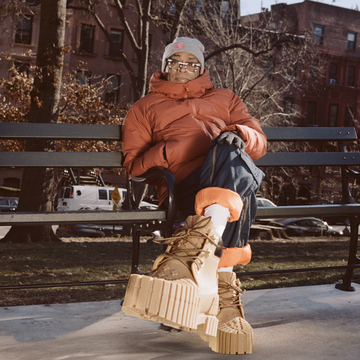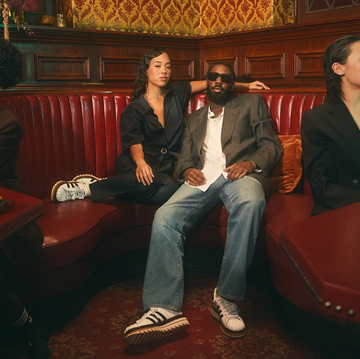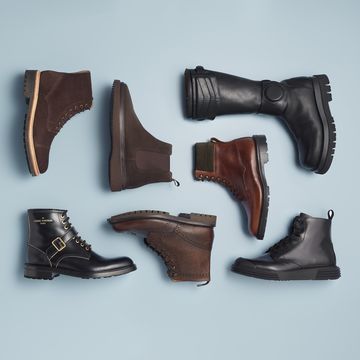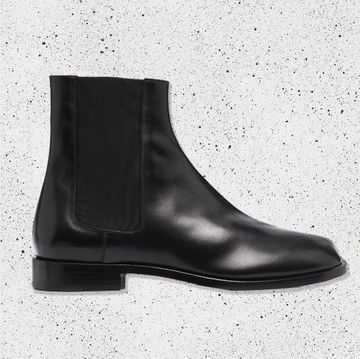John Wildsmith, a third-generation English shoe-maker, famously said, "You are either in your bed or in your shoes, so it pays to invest in both." Sound advice, seeing as a man can walk up to 115,000 miles in his lifetime. But how did this nation come to be such an authority on the craft? In pursuit of the answers, we spoke to some of Britain's leading names in the business, including Grenson, George Cleverley, John Lobb, and Gaziano & Girling which collectively have been keeping the great and the good shod for well over 150 years.
The history of shoe-making in the UK goes back a long way; the Guild of Cordwainers was founded in London in 1272 and is one of the oldest craft institutes in Europe, so Brits have had a fair amount of time to get the practice in. The word cordwainer–denoting a maker of leather shoes–is derived from the Spanish city of Córdoba, which was famed for its exceptional leather. And the use of high-quality leather is paramount to British shoe manufacture.
"Leather is the most important thing that will make a shoe last for a long time or not, depending whether it's good enough. If you look closely, you should be able to see the natural grain of the animal's skin–little dots on the surface–which means it's really good quality. Cheap shoes often have an excessively shiny look as they have a plastic covering to disguise the bad quality leather," says Tim Little, owner and Creative Director of Grenson, which has been manufacturing shoes in Northampton since 1860.
All the leading British shoe firms source their leather from tanneries that have been in the trade for generations, and European box-calf leather is particularly prized for its fineness. "When we make a pair of Grenson shoes, we call the process 'skin to box,' where the leather comes in the front door of the factory and it goes out as a pair of shoes. We use between 200-250 individual processes in the making of our shoes" explains Little.
Traditionally, British shoes are made using a "last"–a wooden mold carved in the shape of a foot. The leather has to be pulled over the last and left for a period of time, which can vary from several days to two weeks or more, so it takes the shape of the shoe. Most good shoe manufacturers will usually state the last number or name for each of their models, so you can become familiar with which last fits you best.
Northampton has long been a mecca for footwear manufacturing–the trade has been part of the local economy since the 12th Century and any brand worth its salt will have a workshop there. "Northamptonshire has an abundance of water sources and had a good supply of hides from the local cattle market. These were the essential ingredients for tanning leather, and so tanneries would grow up around this water. Then of course, shoe-makers started to grow up around the tanneries to make use of the leather," continues Little.
Tanning–the process which preserves leather and makes it suitable for use–is also central to why British shoes are such high quality. Oak-bark tanning, which dates back to Roman times, is used to make the best soles, which are only used in high-end shoes. The oak bark infuses the hide with oils and minerals to give it exceptional longevity and make it supple and resistant to decay. This vegetable-tanning process is labor intensive and time-consuming–it takes at least a year to tan, which is considerably longer than other processes that make use of synthetic chemicals.
In 1973, divers salvaged a cargo of vegetable-tanned leather from the wreck of the Drau Metta Catherina, which sank during a storm off the coast of England in December 1786. Some of this re-claimed hide found its way into the workroom of George Cleverley, the eminent bespoke London shoe-maker who has shod the likes of Samuel L. Jackson, Sir Winston Churchill, Clark Gable, David Beckham, and Jason Statham. "The first pair we made from the 1786 leather was for the Duchy of Cornwall [the current Prince of Wales] and we still use it today," says Adam Law, the label's Head Cutter, who hand-sews the brand's footwear in its Aladdin cave-like workroom in Mayfair. The fact that this leather is still workable after spending almost two centuries on the sea floor is a testament to traditional tanning methods and evidence that the materials are made to last (and then some).
But perhaps the most significant factor which makes British footwear stand out is its solid construction, thanks largely to the Goodyear-welting technique. Although the Goodyear welting machine was patented by an American—Charles Goodyear Jr.—in 1869, the principals of the method originate in 15th Century Europe. It involves stitching a durable strip of leather–known as a welt–to the upper and insole, while a separate stitch is used to attach the outsole. This dual-stitch technique reinforces the shoe and provides resilience in inclement weather, as well ensuring it won't come apart when it's serviced by a cobbler.
"The benefit of a Goodyear welt is that it makes a very strong shoe that can easily be resoled. When you take the sole off, you're still left with that same foundation–you can have the shoe resoled and when it comes back it will already feel broken in," explains Law. The ability to easily fit new soles means that Goodyear-welted shoes can last for decades if properly looked after. They're more expensive at first, sure. But in the long run they'll pay for themselves, as you won't need to keep shelling out for new shoes when yours are getting a little thin in the sole.
The industry suffered a decline throughout the '60s, '70s, and '80s with cheap, mass-produced footwear imports from abroad dealing a hammer-blow to the trade. However, there's no substitute for inherited knowledge, which British firms have in spades. "As with any trade with a focus on quality and craftsmanship, training young artisans is paramount to keeping techniques alive, and the passing down of knowledge is vital," says Paula Gerbase, Artistic Director of John Lobb. "All our shoes are crafted from a single skin, selected from the highest quality leather, and then inspected intricately to ensure of the absence of any flaws, no matter how small."
There's been a marked revival in traditional workmanship in recent years–a trend which can be seen in all genres of the apparel industry, from tailoring to footwear. "We have been encouraged by a recent growing interest in boot-making and are proud to have an expanding team of dedicated apprentices and artisans who are devoted to honing their craft," continues Gerbase.
The firm's founder, John Lobb, had been apprenticed to a shoe-maker in Plymouth as a young man before walking to London in 1851 to further his skills. After a spell in Australia making boots for gold rush miners, he returned to London to set up shop on Regent Street in 1866.
A commitment to innovation remains central to the brand, which has recently developed its unique "tensile" construction, a fresh take on the Goodyear welt. "It has been very popular since it was introduced–it's a Goodyear-welted Northampton-made shoe, but with unparalleled lightness, comfort and flexibility, answering the need to have high quality shoes and boots that last a lifetime, but with the comfort modern life requires," says Gerbase.
Although the British footwear industry is steeped in tradition, it isn't stuck in its ways. Gaziano & Girling, a relative newcomer to the industry, combines exceptional British workmanship with a healthy dash of continental flair. Founded in 2006 by Tony Gaziano and Dean Girling with the aim of shaking up what was a very traditional business, the dynamic duo have, in the words of a client's wife, "made men's shoes sexy" and made Japanese shoe aficionados swoon over their designs.
"Italian footwear was always very elegant and made with very soft leather, almost like a pair of slippers with no structure, whereas a British shoe was made like a tank. You could almost say that our shoes are built like tanks, but with a Ferrari body," says Gaziano, whose father is of Sicilian descent. G&G was the first brand in 100 years to open a new factory in Northampton, which says a lot about its commitment to the craft. "We give you something that will last 20 years, but it doesn't look like a tank on your foot–it looks refined," Gaziano adds. "It can be understated, or classic or contemporary. We're quite unique in that we can put all of that quality structure, craftsmanship into a package that still looks delicate and refined."
Gaziano & Girling, George Cleverley, and John Lobb all have a loyal following for their bespoke services, which let the client decide every detail. It can take between nine months to a year for your first shoe to be made, as the start of the process involves carving an individual last from a solid block of wood, tailored to the exact measurements of your foot. This, understandably, takes time. Once the last has been made, it will be kept by the shoe-maker to mold any repeat orders around and adjusted as your foot changes with age. Multiple fittings are needed, but the end result is a shoe that fits like a glove. Very much the top end of the spectrum, bespoke provides the ultimate experience in comfort and precision—if you have the patience and are willing to invest.
Rather like becoming a Samurai, a bespoke cordwainer needs to dedicate at least four to five years to learning the skills required to make the grade. "A lot of people don't make it," says Tony Gaziano. "From drafting the feet and the last, to cutting the pattern, to making the shoe, it would be about 60-80 hours or more to make a bespoke design," states Dean Girling. "I think men fall in love with a good pair of shoes like an old slipper, which is why you see some bespoke shoes which are 30-40 years old and people are still wearing them," adds Gaziano. "Everything is hand-stitched with our bespoke service, not made by a man using a sewing machine. We pre-pierce the leather with an awl before hand-stitching and we do the same with the soles. You can see the difference in the fineness of the work when you hold a bespoke shoe against a ready-made one," explains Adam Law of George Cleverley.
You may not be ready to drop the kind of cash required for a completely custom pair, but investing in great shoes—British or otherwise—is always a good call. As George Frazier Jr., Esquire US's legendary fashion columnist of the 1960s, said: "Wanna know if a guy is well dressed? Look down."






